How to handle laboratory waste at CBH campus Solna - Scilifelab
PROCEDURE
Decisionmaker: Head of School
Valid from: 7 October 2019
Changed from: 7 Ocotber 2019
Reference number: C-2019-0866
Responsible for review and questions: Infrastructure Manager
1. Purpose
Describe how chemical and hazardous waste is handled at SciLifeLab.
2. Scope
The routine covers all laboratories used by CBH in the ALFA and Gamma houses. Scilifelab complies with KI's regulatory framework.
3. Definitions
- Any chemical residue associated with a hazard label is classified as hazardous waste.
4. Responsibilities
- The Head of the School of Engineering Sciences in Chemistry, Biotechnology, and Health (CBH) is responsible for overseeing waste management within their jurisdiction.
- The infrastructure manager provides guidance for the handling of laboratory waste and contributes to the waste routine review process.
- All employees working in labs are responsible for handling waste according to established routines and rules
- Lab coordinator (administration) is responsible for ensuring hazardous waste containers and labels are always available in room B1121.
- The SciLifeLab administration is responsibile for updating information regarding radioactivity waste handling on the SciLifeLab intranet when needed.
- All employees working with radioactive material at SciLifeLab are responsible for keeping up to date with this procedure and complying.
5. Procedure
The dumping of any chemical waste in the drains is not permitted.
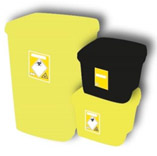
- Yellow plastic bins – are used for the collection of cutting / stabbing / chemical / infectious waste and drug waste.
- Black plastic bins – are used for the collection of biological waste.
Both types of boxes are classified as dangerous goods when transported on public roads placing high demands on safe transport to the destruction plant.
General instructions for the use of waste boxes
- If the box is to be filled with liquid waste, an absorbent cloth should be placed in the bottom.
- The box must not weigh more than 12 kg. NOTE! Do not fill the boxes past the level where the lid can be easily sealed.
- Close the box carefully. The exterior of the box should be clean.
- The box should be labeled with a fully completed label.
- Leave the box in room B1121.
Sharps and infectious waste – “stickande/skärande-smittförande avfall”
Sharp products and needles
All sharp objects including needles, cannulas, scalpels, lancets, suture needles and glass slides must be placed in a small yellow box. When full, this box must be placed in a regular yellow bin.
Infectious waste
Including human blood and blood products, microorganisms, cell cultures and materials that have come into contact with infectious materials such as gloves, pipettes, pipette tips, petri dishes, napkins and the like. The same collection rules apply when the waste is contaminated with minor amounts of drugs or chemicals.
Infected solid waste should be collected in yellow bins. Infected liquid waste should be collected in tight-sealing bottles / dunks and then placed in yellow bins. Use the correct label:
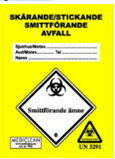
Exceptions
Inactivated/sterilized infectious waste, but only if it has been inactivated/sterilized using an approved method.
NOTE! Antibiotics/cytostatics/chemicals are often used in the same experiment as infectious agents. This mixed waste can always be handled as sharps/infectious waste.
In instances where infectious reagents have been inactivated/sterilized, due to its pharmaceutical/chemical content, the waste should be handled as either “Pharmaceuticals, including cytostatic waste” or “chemical waste”.
Antibiotics that cannot be destroyed by boiling, autoclaving or pH treatment must be disposed as Infectious waste. Most antibiotics are not easily degradeable and must be treated as infectious.
Antibiotics
The sewage facilities at Scilfelab are not equipped to handle pharmaceutical residues. Several common antibiotics are classified as non-biologically degradable and pouring them down the drains entails a risk to the environment. Autoclaving does not result in complete degradation of the majority of antibiotics, and the degradation products that are formed can also have negative impacts on the environment. For these reasons, the dumping of antibiotic waste in the drains is not permitted.
Provided that there is no contamination with live microorganisms that are infectious and/or genetically modified, antibiotic waste shall be handled as “Chemical waste”. Choose a suitable container and label it “Antibiotic-containing solution”.
Cell culture medium that contains antibiotics where the live material has not been killed or which might contain infectious material must be handled as “sharps/ infectious waste”.
Biological waste
Biological wasteincludes “larger samples” of body parts, tissues, teeth and organs from people and animals as well as anatomical preparations.
For ethical reasons, biological waste must be handled separate from other waste.
NOTE! Biological waste must always be stored frozen.
- Biological waste must be placed in black boxes.
- The material must be placed in plastic bags before placing it in the box. Absorbents should be placed in the bottom of the box.
- The bin must be labelled with a fully completed “BIOLOGISKT AVFALL” label (see below). Regardless of whether the animal has been exposed to GMM/microorganisms at Level 2 or a pharmaceutical, only the “BIOLOGISKT AVFALL” label is to be used.
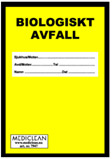
Chemical waste
- Chemical waste includes chemicals labeled with a hazard symbol, including reagent solutions, solvents, oils, colors, adhesives, disinfectants etc.
- Materials, such as gloves, paper towels and test tubes, contaminated with chemicals labeled with "Toxic", "Health Hazard" and / or "Dangerous" Hazard Symbols.
- Bottles and cans labeled with a "Toxic", "Health Hazard" or "Dangerous" symbol. This also applies to empty containers.
- Photochemical waste; developing liquid, fixing liquid and film.
- Some items containing environmentally hazardous metals, for example mercury thermometers.
- Unidentified chemicals (labeled "Unknown Chemicals" under "Content").
NOTE! The dilution of chemicals to negligible concentrations or removal of chemicals via evaporation in the chemical fume hoods is not allowed.
General rules for handling chemical waste
Liquid chemical waste
The can / bottle must not be affected by the contents. For liquid chemical waste, choose original packaging or an appropriate UN-labeled container approved for the transport of dangerous goods.
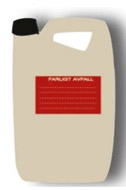
Figure 4: UN-labeled container approved for the transport of dangerous goods.
The container must be sealed properly with an intact lid.
Some liquid chemicals can be mixed, verify this before you combine them by reading the Material Safety Data Sheets.
The container should be labeled with the content, hazard pictogram, date, sender, telephone number and institutional affiliation. Use the labels available in room B1121.
Material contaminated with chemicals that are marked with a "Toxic", "Health Hazard" or "Dangerous" symbol should be packed in plastic bags which are then placed in yellow boxes.
Containers containing chemicals that require permits (A/B rated) shall be labeled with the chemical name and that it is a chemical subject to authorization.
Solid chemical waste
This type of waste can be disposed of in its original packaging or other suitable material – preferably the same type of material that the chemical was originally stored in. Never mix chemicals of different types. The container must be properly sealed.
Attach the “Kem Avfall” label directly on the container. The container must be marked with the contents, date, dispatcher, phone number and department affiliation. If the container has the original markings indicating the correct content, only the dispatcher’s name, department and phone number need to be filled in.
If you are disposing of larger amounts of chemicals, you may put the containers in a yellow waste bin or cardboard box with the “KEM AVFALL” label.
Chemical Waste Mixed with Contaminated Consumables and Sharps
Chemical Material / sharps and consumables contaminated with chemicals labelled with one of the following symbols “Highly toxic”, “Carcinogenic/Mutagenic” and/or “Environmentally toxic” must be either;
- Placed in plastic bags and then put into yellow waste bins (if there is risk of fumes/exposure if the bin is not in a ventilated location). When full, attach a complete “Kem Avfall” label.
- Put in a cardboard waste box (with an inner thick black plastic waste bag). These cardboard boxes are mainly used in our chemical laboratories for the collection of waste in the fume hoods, and are stored in the fume hoods. All sharps should first go into a sharps container which can then be placed into the cardboard box.
Pharmaceutical waste, including cytostatic waste
Pharmaceutical waste includes antibiotics, hormone preparations and cytostatics, vaccines, narcotic drugs and objects that come into contact with these materials, for example packaging that contained antibiotics, cytostatics or other pharmaceuticals.
Note that needles and other sharp waste must be handled as sharp and infectious waste.
NOTE! Pharmaceuticals and cytostatics can pose environmental risks if incorrectly handled. These substances are often slow to degrade and can remain biologically active for a long time after use. They can also be highly toxic, induce mutations or cause hormonal disruptions.
- Waste that has been contaminated with cytostatics and other pharmaceuticals must first be placed in a sealed inner packaging (sealed plastic bag or similar) before being placed in a yellow box with other pharmaceutical waste.
- Liquid pharmaceutical waste must be collected first in leak-proof, sealable bottles/containers and then placed in a yellow bin.
- Complete and use the label “CYTOSTATIKA OCH LÄKEMDELSFÖRORENAT AVFALL”
Note:
- To label “Pharmaceuticals, including cytostatics” waste you must apply two labels; the hazard symbol for “Highly toxic” and the hazard symbol for “Environmentally toxic”.

Empty Bottles / Cans
Bottles and cans that contain residues or are contaminated with chemicals that entail risks for health or the environment shall be handled as “Chemical waste”. Bottles and cans labelled with the hazard symbols “Highly toxic”, “Carcinogenic/Mutagenic” and/or “Environmentally toxic” must always be handled as “Chemical waste” even when empty. Normal recycling centers will not accept packaging with such labels.
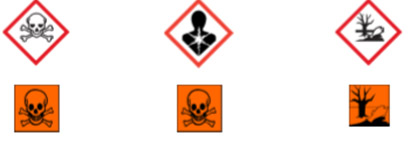
Clean packaging that does not have the above hazard symbols shall be handled as normal waste, i.e. sorted as glass, hard plastics, etc. – but only if it does not contain residues, dust or droplets! Sealed packaging that has contained flammable goods must be opened and rinsed carefully with water to prevent the production of flammable vapors after the packaging is placed in the source sorting bins. The packaging should be discarded without a lid to further minimize the risk of fire.
In cases of doubt, packaging should be handled as chemical waste.
Radioactive waste
Always contact the SciLifeLab Lab Coordinator for information on radioactive waste handling when planning such experiments.
Detailed instructions for handling different types of radioactive waste can be found in KI's local radiation protection regulations and in the local laboratory license. Requirements related to handling radioactive waste can be found in SSMFS 2010:2.
- We must document all the radioactive waste (solid and liquid) we discard
- Radioactive waste must be dealt with separately and must not be disposed of with normal waste.
- The green waste bins (see below) should be used for all radioactive waste.
- There is a separate room, with a code lock in the basement waste room, designated for radioactive waste.

Hazardous waste collection
Hazardous waste is collected by Stena from the designated room at “Godsmottagningen” floor 1. At pick-up the personnel from Stena is responsible for writing a Transportdokument”, the personnel at “Godsmottagningen” will sign the document. Stena sends a copy of the “Transportdokument” to “Godsmottagningen” on arrival at the company, that copy will be archived at “Godsmottagningen”.
6. Attachments
None.
7. Amendments
| Approved version | Document Date | Amendment | Name |
|---|---|---|---|
| 01 | 2018-04-03 | New routine; due to the school re-organization this document replaces MR-BIO-022 and MR_BIO-188. |
Kicki Holmberg |
| 02 | 2018-06-03 | Information regarding handling of the Transport document | Kicki Holmberg |
| 03 | 2019-04-16 | Routine moved to a new format. Revision of routine due to a new organization of the environmental management system, in which the environmental representatives’ role is replaced by responsible functions. This document replaces MR-CBH-004. | Sara Pettersson |

